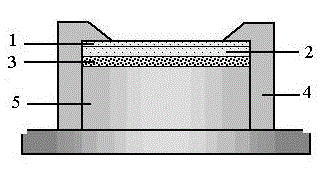Method for selectively and quantitatively collecting Cd in water environment
A technology for quantitative collection and water environment, which is applied in the direction of testing water, material inspection products, etc., to achieve the effects of saving manpower and material resources, simple collection devices, and economical and practical methods.
- Summary
- Abstract
- Description
- Claims
- Application Information
AI Technical Summary
Problems solved by technology
Method used
Image
Examples
Embodiment 1
[0034] Using 100 mg of molecularly imprinted polymer, put it in the collection device together with the dialysis membrane, seal the collection device with cellulose film, and then put 36 identical collection devices in the natural freshwater environment for 1 year, every Three samples were taken out every month (calculated as 30 days), and the concentration of Cd in the water was measured by atomic absorption spectrometry, and the average concentration of Cd in the water system during the storage time was calculated.
[0035] At the same time, the conventional sampling method was used to take water samples every three days to measure the concentration of Cd by atomic absorption spectrometry. During the monitoring period, the average concentration of Cd measured by the present invention and the ratio of the Cd content measured by conventional methods in the same period are in the range of 85%-120%, which shows that the present invention can accurately monitor Cd pollution or con...
Embodiment 2
[0037] Using 80 mg of molecularly imprinted polymer, put it together with chromatographic paper in the collection device, seal the collection device with cellulose film, and then put 30 identical collection devices in the natural mineralized water system for 10 months, Take out 3 samples every month (according to 30 days), use the atomic absorption spectrometry to measure the concentration of Cd, and calculate the average concentration of Cd in the water system during the storage time, and use the conventional sampling method to take a sample of the water every three days The concentration of Cd in water samples was determined by atomic absorption spectrometry.
[0038] During the monitoring period, the average concentration of Cd measured by the present invention and the ratio of the Cd content measured by conventional methods in the same period are in the range of 85%-120%, which shows that the present invention can accurately monitor Cd pollution or contain Cd in the water s...
Embodiment 3
[0040] Use 50 mg of molecularly imprinted polymer, put it together with the dialysis membrane in the collection device, seal the collection device with cellulose film, put 12 identical collection devices in the sewage, leave it for 1 month, and take it out every week 3, use atomic absorption spectrometry to measure the concentration of Cd, and calculate the average concentration of Cd in the water system during the storage time, and use the conventional sampling method to take water samples from the water area every three days and use atomic absorption spectrometry to determine the concentration of Cd concentration.
[0041] During the monitoring period, the average concentration of Cd measured by the present invention and the ratio of the Cd content measured by conventional methods in the same period are in the range of 85%-120%, which shows that the present invention can accurately monitor Cd pollution or contain Cd in the water system Cd content.
PUM
 Login to View More
Login to View More Abstract
Description
Claims
Application Information
 Login to View More
Login to View More - R&D Engineer
- R&D Manager
- IP Professional
- Industry Leading Data Capabilities
- Powerful AI technology
- Patent DNA Extraction
Browse by: Latest US Patents, China's latest patents, Technical Efficacy Thesaurus, Application Domain, Technology Topic, Popular Technical Reports.
© 2024 PatSnap. All rights reserved.Legal|Privacy policy|Modern Slavery Act Transparency Statement|Sitemap|About US| Contact US: help@patsnap.com








